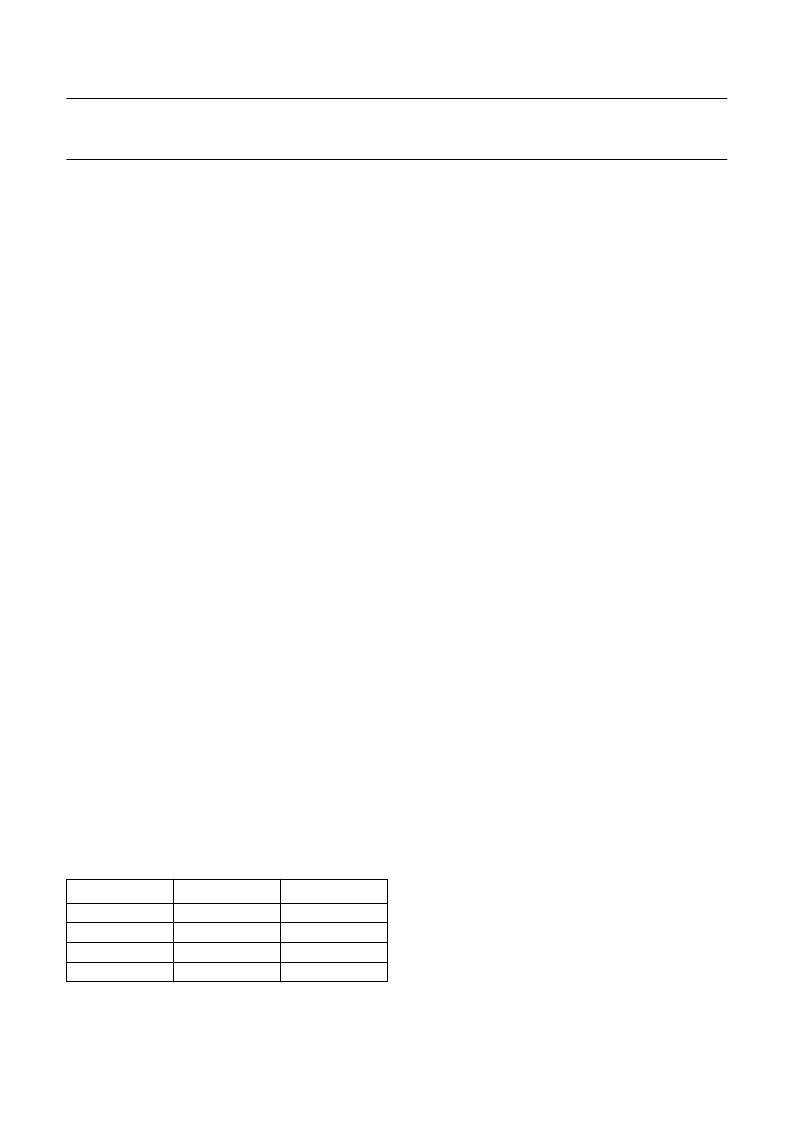- 您現(xiàn)在的位置:買賣IC網(wǎng) > PDF目錄382721 > UDA1350ATS (NXP SEMICONDUCTORS) IEC 958 audio DAC PDF資料下載
參數(shù)資料
| 型號: | UDA1350ATS |
| 廠商: | NXP SEMICONDUCTORS |
| 元件分類: | 消費(fèi)家電 |
| 英文描述: | IEC 958 audio DAC |
| 中文描述: | SPECIALTY CONSUMER CIRCUIT, PDSO28 |
| 封裝: | PLASTIC, SSOP-28 |
| 文件頁數(shù): | 9/32頁 |
| 文件大小: | 124K |
| 代理商: | UDA1350ATS |
第1頁第2頁第3頁第4頁第5頁第6頁第7頁第8頁當(dāng)前第9頁第10頁第11頁第12頁第13頁第14頁第15頁第16頁第17頁第18頁第19頁第20頁第21頁第22頁第23頁第24頁第25頁第26頁第27頁第28頁第29頁第30頁第31頁第32頁

2000 Mar 29
9
Philips Semiconductors
Preliminary specification
IEC 958 audio DAC
UDA1350ATS
The extracted key parameters are:
Pre-emphasis
Audio sample frequency
Two-channel PCM indicator
Clock accuracy.
Both the lock indicator and the key channel status bits are
accessible via the L3 interface.
The UDA1350ATS supports the following sample
frequencies and data bit rates:
f
s
= 32.0 kHz, resulting in a data rate of 2.048 Mbits/s
f
s
= 44.1 kHz, resulting in a data rate of 2.8224 Mbits/s
f
s
= 48.0 kHz, resulting in a data rate of 3.072 Mbits/s.
The UDA1350ATS supports timing level I, II and III as
specified by the IEC 958 standard.
8.4.2
A
UDIO FEATURE PROCESSOR
The audio feature processor automatically provides
de-emphasis for the IEC 958 data stream in the static pin
control mode and default mute at start-up in the L3 control
mode.
When used in the L3 control mode it provides the following
additional features:
Volume control using 6 bits
Bass boost control using 4 bits
Treble control using 2 bits
Mode selection of the sound processing bass boost and
treble filters: flat, minimum and maximum
Soft mute control with raised cosine roll-off
De-emphasis selection of the incoming data stream for
f
s
= 32.0, 44.1 and 48.0 kHz.
8.4.3
I
NTERPOLATOR
TheUDA1350ATSincludesanon-boardinterpolatingfilter
which converts the incoming data stream from 1f
s
to 128f
s
by cascading a recursive filter and a FIR filter.
Table 2
Interpolator characteristics
8.4.4
N
OISE SHAPER
The third-order noise shaper operates at 128f
s
. It shifts
in-band quantization noise to frequencies well above the
audio band. This noise shaping technique enables high
signal-to-noise ratios to be achieved. The noise shaper
output is converted into an analog signal using a filter
stream digital-to-analog converter.
8.4.5
F
ILTER STREAM
DAC
The Filter Stream DAC (FSDAC) is a semi-digital
reconstruction filter that converts the 1-bit data stream of
the noise shaper to an analog output voltage. The filter
coefficients are implemented as current sources and are
summed at virtual ground of the output operational
amplifier. In this way very high signal-to-noise
performance and low clock jitter sensitivity is achieved. A
post filter is not needed due to the inherent filter function of
the DAC. On-board amplifiers convert the FSDAC output
current to an output voltage signal capable of driving a line
output.
The output voltage of the FSDAC is scaled proportionally
with the power supply voltage.
8.5
Control
The UDA1350ATS can be controlled by means of static
pins or via the L3 interface. For optimum use of the
features of the UDA1350ATS the L3 control mode is
recommended since only basic functions are available in
the static pin control mode.
It should be noted that the static pin control mode and
L3 control mode are mutual exclusive. In the static pin
control mode pins L3MODE and L3DATA are used to
select the format for the data output and input interface.
PARAMETER
CONDITIONS
VALUE (dB)
±
0.03
50
115
3.5
Pass-band ripple
Stop band
Dynamic range
DC gain
0 to 0.45f
s
>0.65f
s
0 to 0.45f
s
相關(guān)PDF資料 |
PDF描述 |
|---|---|
| UDA1351 | 96 kHz IEC 958 audio DAC |
| UDA1351H | 96 kHz IEC 958 audio DAC |
| UDA1351TS | 96 kHz IEC 958 audio DAC |
| UDA1352HL | 48 kHz IEC 60958 audio DAC |
| UDA1360 | Low-voltage low-power stereo audio ADC |
相關(guān)代理商/技術(shù)參數(shù) |
參數(shù)描述 |
|---|---|
| UDA1351 | 制造商:PHILIPS 制造商全稱:NXP Semiconductors 功能描述:96 kHz IEC 958 audio DAC |
| UDA1351H | 制造商:PHILIPS 制造商全稱:NXP Semiconductors 功能描述:96 kHz IEC 958 audio DAC |
| UDA1351H/N1,551 | 功能描述:數(shù)模轉(zhuǎn)換器- DAC 96 KHZ SPDIF DAC RoHS:否 制造商:Texas Instruments 轉(zhuǎn)換器數(shù)量:1 DAC 輸出端數(shù)量:1 轉(zhuǎn)換速率:2 MSPs 分辨率:16 bit 接口類型:QSPI, SPI, Serial (3-Wire, Microwire) 穩(wěn)定時(shí)間:1 us 最大工作溫度:+ 85 C 安裝風(fēng)格:SMD/SMT 封裝 / 箱體:SOIC-14 封裝:Tube |
| UDA1351H/N1,557 | 功能描述:數(shù)模轉(zhuǎn)換器- DAC 96 KHZ SPDIF DAC RoHS:否 制造商:Texas Instruments 轉(zhuǎn)換器數(shù)量:1 DAC 輸出端數(shù)量:1 轉(zhuǎn)換速率:2 MSPs 分辨率:16 bit 接口類型:QSPI, SPI, Serial (3-Wire, Microwire) 穩(wěn)定時(shí)間:1 us 最大工作溫度:+ 85 C 安裝風(fēng)格:SMD/SMT 封裝 / 箱體:SOIC-14 封裝:Tube |
| UDA1351TS | 制造商:PHILIPS 制造商全稱:NXP Semiconductors 功能描述:96 kHz IEC 958 audio DAC |
發(fā)布緊急采購,3分鐘左右您將得到回復(fù)。